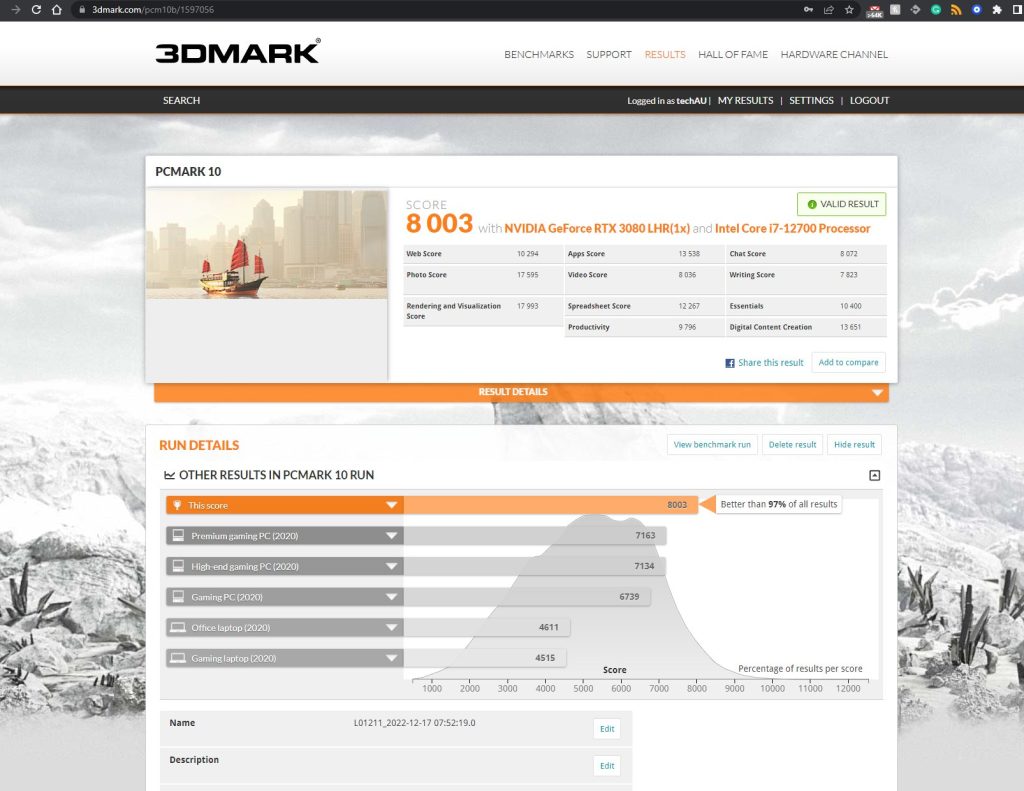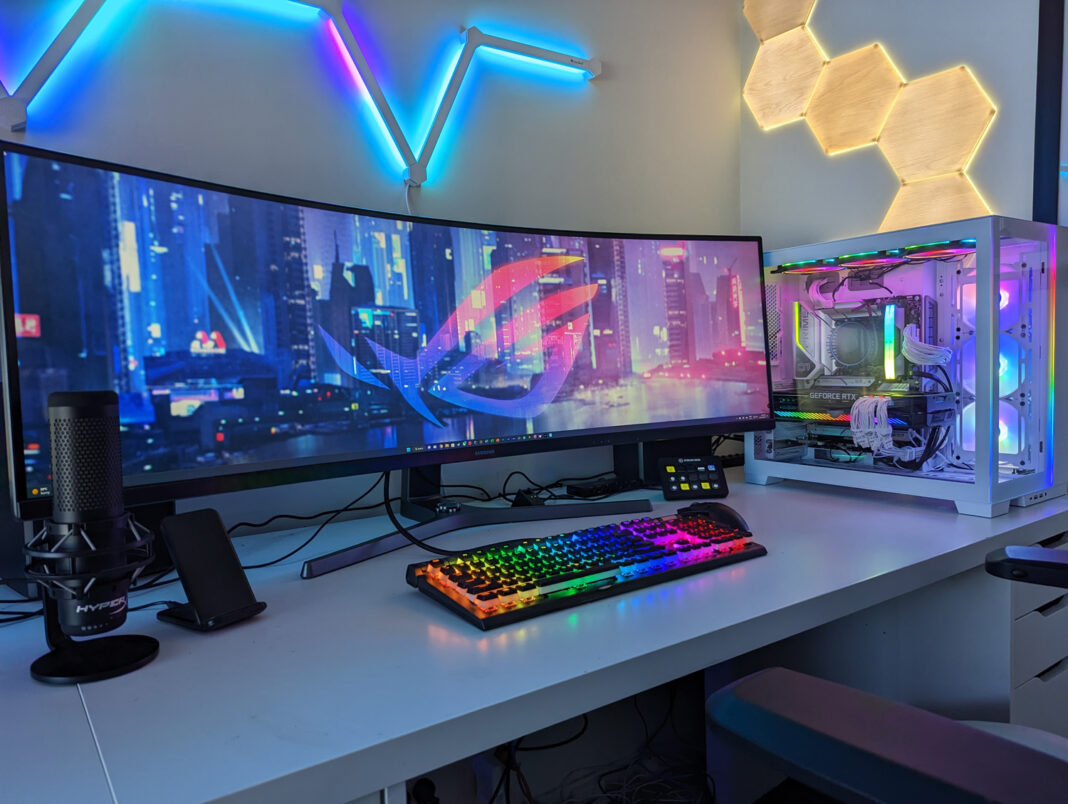テクノロジー
It’s been more than 5 years since I built myself a new PC, but in late 2022, I’ve now created a new video editing/gaming rig.
If you’re in the market for a new PC, you can of course buy a pre-made system, but there’s something really rewarding about researching the right components, setting a budget, and making your selections to create a PC that’s specifically tailored for your needs.
After spending a few days researching components, and considering the performance and design I wanted from a new PC, I made my choices for each of the critical components. Many online retailers allow you to build a PC online, ensuring you don’t miss important parts of the build and allow you to compare and contrast a few different configurations and even send it to friends for feedback.
What I found worked well was to balance the budget between a GPU and the other components and there’s an added reason for this which I’ll get to soon.
GPUs I believe are the hardest choice right now, particularly for those in the Nvidia camp, as we have the 4000 series cards, but their price is kind of outrageous. If you have an unlimited budget, go crazy, but personally, I wanted performance, but not at all costs, as I knew that any new PC in 2022 would significantly beat the performance of my old PC. Ideally, I would end up with a machine that allowed me to play with graphic settings on Ultra for all games, but I knew I couldn’t spend the world on this but could build it cheaper myself than paying others to assemble it for me and I think you can too, it’s really not that hard.
When you get to the checkout, there are a number of different payment options you have available to you, but one is PayPal’s Pay-in-4 which takes the price of an order and allows you to pay 4 equal payments over 4 weeks. At the time of purchase, the first payment comes out, but leaves the remaining balance of the price tag in your account, helping offset your mortgage. Over the subsequent 4 weeks, the remaining 3 payments will be debited from your account. There is one restriction with this, there’s a cap of $2,000 on each Pay-in-4 payment, so I split my order in 2, 1 for the GPU and 1 for the remaining parts of the build.
After clicking buy, in just a few days, the components arrived at my door, making for a great early Christmas present.
The goal of the new gaming rig is to build something that performs and looks good doing it. My first frustration was mainly in editing video, as the quality of video coming from drones, GoPros and phones moved beyond 4K, it became obvious that the old GTX1080 was no longer adequate.
In early December, I published the details of the build, but now it’s a reality.
テクノロジー New PC specs
- Case: Lian Li PC-O11 Dynamic EVO Tempered Glass Case White
- Motherboard: ASUS Prime Z690-A DDR5
- CPU: 12th-gen Intel Core i7 12700 CPU
- RAM: 32GB of Corsair Vengeance CL40 DDR5 RAM, running at 5200MHz
- PSU: ASUS ROG Strix Gold 850W White Modular PSU
- GPU: ASUS ROG Strix GeForce RTX 3080 OC LHR 10GB
- Storage: Samsung 1TB SSD 970 EVOPlus
- Cooling: 2x Triple RGB fans (more on the way), stock CPU/GPU coolers.
- Extras: WiFi 6e / BT5.2 PCI-E card.
テクノロジー Lesson’s learned
After hitting buy on the order, I started thinking about the actual assembly process and remembered I didn’t configure fans for cooling. I knew the CPU, GPU and Power Supply had their own cooling sorted, but what about the general airflow through the case?
Some cases come with at least 1 fan, so I started researching a little more about the case I bought and realised this one didn’t. I ordered some white fans to match the case, but unfortunately, there were none that would arrive in time. I wasn’t about to let fans delay me from building this PC, so was prepared to run it with the side of the case off if I had to.
I did indeed opt for this for about a day and a half, before opting for a plan B. That plan B was to get some fans from a local PC accessories shop. Of course, they didn’t stock any fans, so I went with 3x black fans and mounted them on the top of the case, mostly out of sight, but successfully drew air out of the case.
In hindsight, I would have thought about case cooling more and ordered white fans with the original order.
My second opportunity for improvement was the motherboard selection. While I’m insanely happy with the features and function of the Asus Z690-A, there is no onboard WiFi or Bluetooth. Had I taken a little longer to research and double-check what I assumed was standard inclusions, I would have seen that omission and opted for the WiFi version of this board.
Thankfully the solution here was a really simple one. After about 5 minutes on Amazon, I ordered a PCI-E WiFi 6/Bluetooth card and 2 days later it arrived. 5 minutes later it was installed on my PC and I have Bluetooth speakers connected to it successfully.
テクノロジー Performance
So after all the building is done, where did we land with performance? There are two major ways to determine performance, one is benchmarking and one is more anecdotal, but maybe more important, it’s how you feel when using the computer.
On the first, I ran PC Mark 10 and scored the highest-ever result, with an 8,003 scoring better than 97% better than all other results, I was pretty happy with that.
What I can say, is that the benchmarks I had for a new PC were certainly much more than a single number. The speed and performance of a computer is perceived through a number of characteristics.
The first is how fast the computer turns on and/or wakes from sleep as this is the time you’ll be faced with waiting every time you use your PC, or restart it. Thankfully the result is amazing, waking from sleep takes literally a few seconds, then with Windows Hello (Logitech Brio), it logs me in and I’m right at the desktop in seconds, the first of many dramatic improvements over where I was. Even from a cold boot, the system takes just 20 seconds from bios screen to Windows login.
The next metric is really around gaming performance. To test this, I jump into as many games as possible, the more recent the better and crank all the quality settings to max (Ultra in many cases). Even running 5120×1440 resolution, there hasn’t been a game yet that I’ve tried that doesn’t offer an incredibly smooth and amazing gaming experience.
This is exactly what I had hoped for when spending half the build cost on the GPU alone. Given I was seeing frame rates around 100fps with the RTX3080, I expect the additional performance available with a 4000 series card would be wasted.
My next tests were Adobe products, which I use to batch-compress images and edit and export videos. There’s really no comparison between this computer and my last, completely a night and day experience. With a similar length and quality Premier Project, the export time has been reduced from around 20 minutes to around 2 minutes, at around a 10x improvement, I couldn’t be happier.
The other main frustration I had with the old PC was in editing footage that was above 4K quality. Even with playback set to half resolution, I struggled to make quick edits and changes to the video layers, making video editing insanely time-consuming, but wanting to always start with the highest source material, I now have the PC to match the quality available from modern GoPro’s, Drones and Phones.

テクノロジー Video: Hands-on build
If you want to watch the build happen, then check out the video below. It doesn’t show every step but does show the majority of the build.
テクノロジー Price and Availability
You would think all of these components are readily available and that’s the case for most, however the ASUS Geforce RTX3080 was discontinued from the supplier just days after I purchased it. With the next card up being hundreds of dollars more expensive, I am glad I got in when I did.
The total cost of this build was A$3,397 delivered. This same build 6-12 months ago could have easily cost another A$1,000 on top, so I’m happy with the price and I’ve certainly seen many store-build PCs of similar specs cost hundreds of dollars more.
- Case: Lian Li PC-O11 Dynamic EVO Tempered Glass Case White – $269.00
- Motherboard: ASUS Prime Z690-A DDR5 – $449.00
- CPU: 12th-gen Intel Core i7 12700 CPU – $519.00
- RAM: 32GB of Corsair Vengeance CL40 DDR5 RAM, running at 5200MHz – $299.00
- PSU: ASUS ROG Strix Gold 850W White Modular PSU – $289.00
- GPU: ASUS ROG Strix GeForce RTX 3080 OC LHR 10GB – $1,499.00
- Storage: Samsung 1TB SSD 970 EVOPlus (existing)
- Cooling: 2x Triple RGB fans (more on the way), stock CPU/GPU coolers. ($105 post-build)
- Extras: WiFi 6e / BT5.2 PCI-E card- $45.00 (post-build)

テクノロジー Overall
I really couldn’t be happier with this PC build. It is easily the best performing computer I’ve build and/or used and I think it’s also the best looking computer I’ve built too.
Upon refelction, the components I chose have combined to create a great performing PC that will serve me well now and into the future with plenty of room to upgrade. While I have a 12th gen Intel processor right now, the Motherboard actually supports both 12th and 13th gen Intel chips, offering a good path forward if I feel I’m CPU limited in the future.
I currently have 2 of the 4 DDR5 memory slots filled, which is also a great avenue to increase performance in the future, for fairly low cost.
When it comes to storage, there are no less than 4 M.2 SSD slots on this board, as well as plenty of room for 2.5″ and 3.5″ drives, so there should defintiely be no problems with future storage upgrades.
Finally the GPU. Right now I’m running the card in its stock configuration, but it is possible to overclock this to extract even more performance. With an 850W power supply and the mandatory 3x 8 ping power connectors, it would be possible to switch this out for a 4000 series in years to come, once the price drops below the cost of a small car.
Ultimately the combination of components that makup this PC are well balanced and there’s no single bottleneck to performance right now.
There is certainly a real sense of satisfaction in building your own PC, turning it on and having all parts work well together. This is the physical and digital result of lots of research and putting your own cash on the line to get the outcome you wanted. I’d highly recommend this to anyone who’s considering a PC build, just be ruthless in sticking to your budget as this can easily get out of control.



